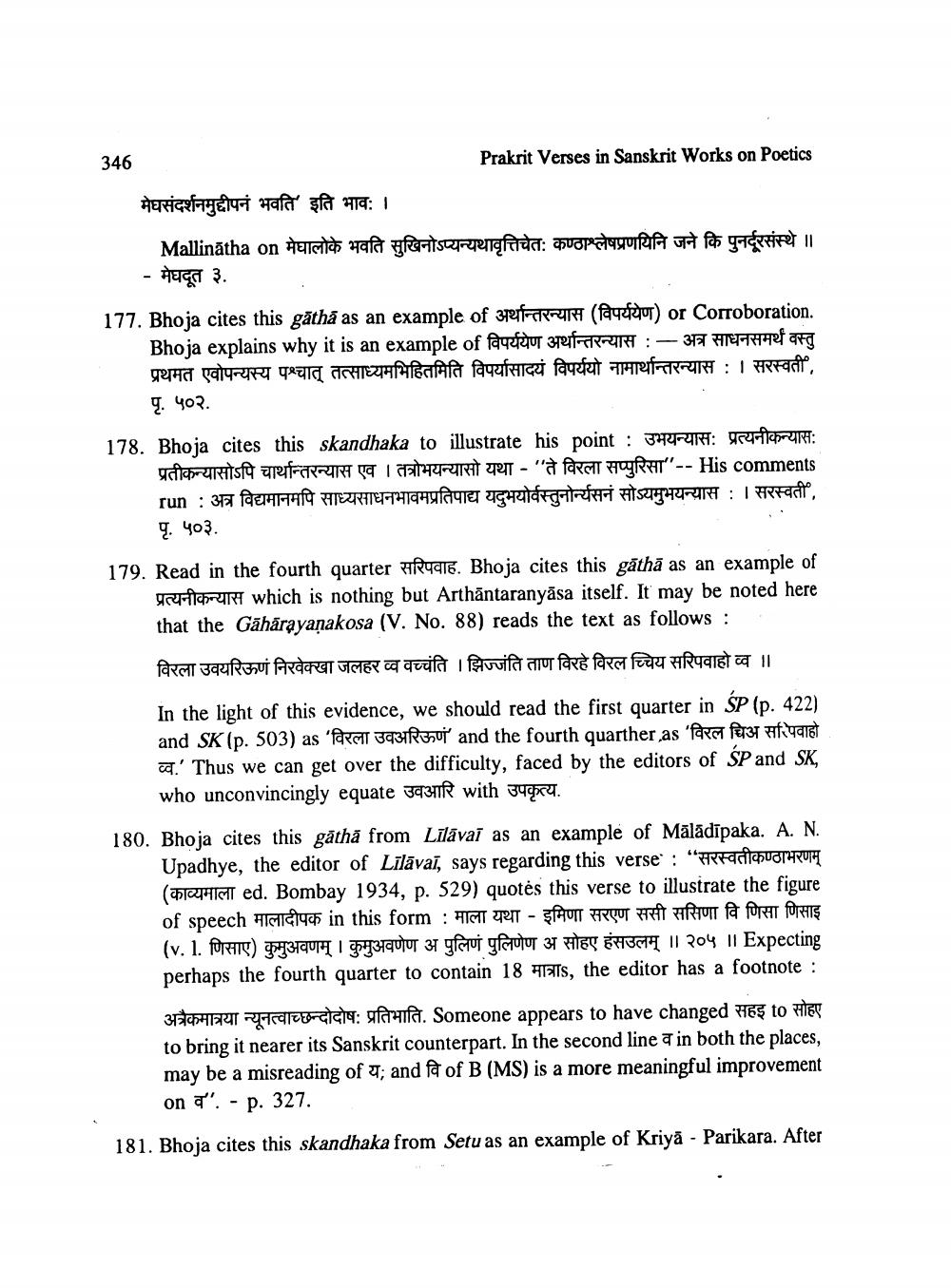________________
346
Prakrit Verses in Sanskrit Works on Poetics
मेघसंदर्शनमुद्दीपनं भवति इति भावः ।
Mallinātha on मेघालोके भवति सुखिनोऽप्यन्यथावृत्तिचेत: कण्ठाश्लेषप्रणयिनि जने कि पुनर्दूरसंस्थे ।। - मेघदूत ३.
177. Bhoja cites this gatha as an example of अर्थान्तरन्यास (विपर्ययेण) or Corroboration.
Bhoja explains why it is an example of विपर्ययेण अर्थान्तरन्यास :- अत्र साधनसमर्थं वस्तु प्रथमत एवोपन्यस्य पश्चात् तत्साध्यमभिहितमिति विपर्यासादयं विपर्ययो नामार्थान्तरन्यास : । सरस्वती, पृ. ५०२.
178. Bhoja cites this skandhaka to illustrate his point : उभयन्यास: प्रत्यनीकन्यास:
प्रतीकन्यासोऽपि चार्थान्तरन्यास एव । तत्रोभयन्यासो यथा - "ते विरला सप्पुरिसा"-- His comments run : अत्र विद्यमानमपि साध्यसाधनभावमप्रतिपाद्य यदुभयोर्वस्तुनोर्व्यसनं सोऽयमुभयन्यास : । सरस्वती, पृ. ५०३.
179. Read in the fourth quarter सरिपवाह. Bhoja cites this gatha as an example of
प्रत्यनीकन्यास which is nothing but Arthāntaranyasa itself. It may be noted here that the Gaharayanakosa (V. No. 88) reads the text as follows :
विरला उवयरिऊणं निरवेक्खा जलहर व्व वच्चंति । झिज्जति ताण विरहे विरल च्चिय सरिपवाहो व्व ॥
In the light of this evidence, we should read the first quarter in SP (p. 422) and SK (p. 503) as "विरला उवअरिऊणं' and the fourth quarther as 'विरल चिअ सरिपवाहो ca. Thus we can get over the difficulty, faced by the editors of SP and SK, who unconvincingly equate उवआरि with उपकृत्य.
180. Bhoja cites this gatha from Lilavai as an example of Maladipaka. A. N.
Upadhye, the editor of Lilavai, says regarding this verse: "सरस्वतीकण्ठाभरणम् (काव्यमाला ed. Bombay 1934, p. 529) quotes this verse to illustrate the figure of speech मालादीपक in this form : माला यथा - इमिणा सरएण ससी ससिणा वि णिसा णिसाइ (v. 1. णिसाए) कुमुअवणम् । कुमुअवणेण अ पुलिणं पुलिणेण अ सोहए हंसउलम् ॥ २०५ || Expecting perhaps the fourth quarter to contain 18 मात्राs, the editor has a footnote :
अत्रैकमात्रया न्यूनत्वाच्छन्दोदोष: प्रतिभाति. Someone appears to have changed सहइ to सोहए to bring it nearer its Sanskrit counterpart. In the second line a in both the places, may be a misreading of u; and of B (MS) is a more meaningful improvement on d". - p. 327.
181. Bhoja cites this skandhaka from Setu as an example of Kriya - Parikara. After




